Egyptian Gods of the Ogdoad
- Details
- Written by AndEl
Egyptian Gods of the Ogdoad
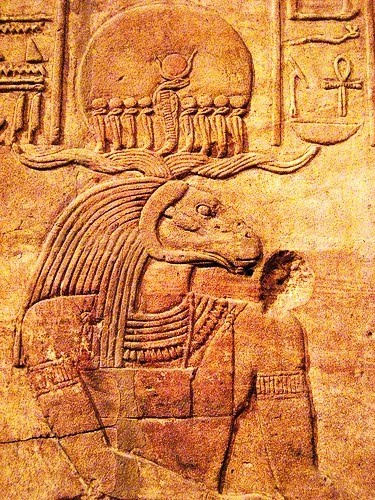
According to the myth, there was a watery mass of dark, directionless chaos was the only thing existed on earth before there was land. There were four frog gods and four snake goddesses who lived this chaos. They were four pair of deities, Nun and Naunet (the primordial water), Amun and Amaunet (representing hiden powers), Kuk with Kauket (darkness) and Heh and Hauhet (infininte space). This group of eight gods formed the Ogdoad. Then very first land was rose out of Nun in the form of mound.
Ancient Egyptian Gods and Goddesses
Darkness was all there was in the beginning. The Ogdoad then awakened – Nun and Naunet, Amun and Amaunet, Ku and Kauket, and Hu and Haunet. In concert they raised a hill out of the first waters. An egg was on this hill, and from it, the god Atum – the father of all – was born.
The Ogdoad then withdrew to see the manner in which the world would unfold, leaving Atum all alone. Atum then spat on the primeval ground, thus giving birth to his daughter, Tefnut, and son, Shu. Atum gave his blessings to Tefnut and Shu, giving them great powers. To Tefnut he granted power over moisture, and to Shu he granted power over the sky and earth. Together they set about separating the sky from the world, and the land from the water.
During this great upheaval, however, Tefnut and Shu got lost in the chaotic darkness, for they did not have Atum’s power to surmount it. In his great grief Atum ripped out his all-seeing eye, bidding it to seek Tefnut and Shu, and bring them back. Soon Tefnut and Shu came back with the eye, which Atum affixed on his crown in order to be able to see all. (This is the eye that can be seen in the pharaoh’s crown, the Udjat Eye.)
The sight of his children filled Atum with joy, which caused him to weep great tears. When the tears fell on the ground, it caused life to spring up all over the earth. Tefnut was taken as wife by Shu, and she gave birth to Nut and Geb. Nut became the goddess of the celestial sphere, held up by Tefnut and Shu, and Geb became the god of the earth.
Nut, thereafter, gave birth to the gods Set and Osiris and the goddesses Nephthys and Isis by her brother and husband, Geb. They were the very first gods and goddesses of men and the world, while the rest became the great gods of the sky and earth.
The gods of the Ogdoad are represented as frogs or with the head of a frog; the goddesses in the shape of a snake or as a woman with the head of a snake. Their cult centered on the town of Khemnu (Greek Hermopolis) in Middle Egypt. They also had a sanctuary at Medinet Habu in western Thebes.
Nun
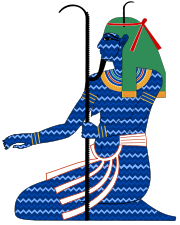 The primeval water that encircles the entire world, and from which everything was created, personified as a god. He is considered to be a more ancient god then the sun-god Re, who arose from this water. Nun (Nu) was one of the oldest Egyptian gods in ancient Egyptian history referred as the “father of the god”. The name Nun means “primeval waters” from which the creation was began. Nun has no gender, but has the aspect that can represent as male or female. Nun is the male aspect and Naunet also known as Nunet is the female aspect. With the goddess Naunet he forms a pair in the Ogdoad of Hermopolis. Nun played no part in religious rituals and had no temples dedicated to him. He was symbolized by the sacred lakes associated with certain temples, such as the ones at Dendera and Karnak. The Egyptians also believe that Nun will continue to exist as the source of the annual flooding of the Nile River.
The primeval water that encircles the entire world, and from which everything was created, personified as a god. He is considered to be a more ancient god then the sun-god Re, who arose from this water. Nun (Nu) was one of the oldest Egyptian gods in ancient Egyptian history referred as the “father of the god”. The name Nun means “primeval waters” from which the creation was began. Nun has no gender, but has the aspect that can represent as male or female. Nun is the male aspect and Naunet also known as Nunet is the female aspect. With the goddess Naunet he forms a pair in the Ogdoad of Hermopolis. Nun played no part in religious rituals and had no temples dedicated to him. He was symbolized by the sacred lakes associated with certain temples, such as the ones at Dendera and Karnak. The Egyptians also believe that Nun will continue to exist as the source of the annual flooding of the Nile River.
Nun is portrayed as a bearded man or a frog headed man with blue green skin which represents water and wearing the palm frond that symbolized long life, one on his head, and another on his hand. Naunet is portrayed as a snake headed woman or as a snake itself. Sometimes Nun is depicted in human form holding the solar barque above his head.
Naunet
An Egyptian goddess who representes the primordial abyss of the underworld. Her male counterpart, as well as her consort, is Nun. In the cosmogony of Hermopolis she was a member of the Ogdoad of eight primordial deities.
Amun
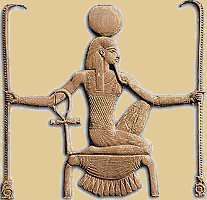 A primordial Egyptian god, whose name means "the hidden one". As the driving force of the invisible breeze he was originally a god of wind and ruler of the air. During the 11th dynasty (2133 - 2000 BCE) he became the powerful sun-god of Thebes, where he was worshipped as Amun-Re. Later he was made the supreme god of the entire realm and king of the gods.
A primordial Egyptian god, whose name means "the hidden one". As the driving force of the invisible breeze he was originally a god of wind and ruler of the air. During the 11th dynasty (2133 - 2000 BCE) he became the powerful sun-god of Thebes, where he was worshipped as Amun-Re. Later he was made the supreme god of the entire realm and king of the gods.
In the Ogdoad of Hermopolis he forms a pair with the mother-goddess Amaunet. From his union with the goddess Mut came forth the moon-god Chons. Amun's symbol is the ram. He is portrayed as a ram, as a man with a ram's head, or with a beard and a feathered crown. Amun has also been portrayed as a men wearing a ram crown with two tall ostrich feathers on his head, holding scepter in one hand and the ankh in the other.Temples dedicated to him are situated as Karnak and Deir-el-Bahari (near Luxor). In Greece he was worshipped as Ammon. The name Amun is also spelled as Amon, Amoon, or Amen.
Amaunet
An Egyptian mother goddess, called the "Hidden One". She is the personification of the life-bringing northern wind. She belongs to the Ogdoad of Hermopolis. Within this group of gods her consort is the god Amun. She is referred to as 'the mother who is father' and in this capacity she needs no husband. Amaunet was regarded as a tutelary deity of the Egyptian pharaohs and had a prominent part in their accession ceremonies. She is portrayed as a snake or a snake-head on which the crown of Lower Egypt rests.
Amunet was an ancient Egyptian Fertility Goddess of Upper Egypt. The name Amunet also spelled as Amonet, Amaunet, Amentet, Amentit, Imentet, Imentit or Ament, whose name means “She of the West”, as she is regarded as a personification of the direction West.
She is one of the eight primeval gods in the Ogdoad, forming the female counterpart of Amun, whose name means “The Hidden One” as the invisible air and wind. According to some myths Amunet was the daughter of Horus and Hathor. She was also sometimes merged with Hathor, Isis and Neith, Mut, and Nut.
The name hidden one was also sometimes used to refer to the underworld, and so Amaunet became more associated with welcoming the newly dead. Amunet depicted as a woman with the head of snake or as a snake, like all females deities in the Ogdoad.
Amunet appearance portrayed as a woman wearing a sign representing the west (a semi circle on top of one long and one short pole) and of hawk or ostrich feather on the head. Occasionally, she was shown carrying a scepter and the ankh of life in hand. Sometimes, she was also depicted as a winged goddess.
Amun’s consort Amunet later was replaced by Mut. Though Amunet less important than Mut, she remains the consort of Amun at Karnak, the main center of worship.
Kuk
An Egyptian primordial god, one of the Ogdoad of Hermopolis. Together with Kauket he represents the darkness of primal chaos. They produce the twilight from which the light is created.
Kuk (Kek or Keku) was one of the oldest Egyptian gods in ancient Egyptian history is the deification of the primordial concept of darkness. The name Kuk means darkness, the god of the darkness of chaos before the creation was began. Kuk has no gender, but has the aspect that can represent as male or female. Kuk is the male aspect and Kauket also known as Keket is the female aspect.
Kuk is portrayed as a man with the head of frog or as a frog itself. Kauket is portrayed as a woman with the head of snake or as a snake itself. Kuk represented darkness, obscurity and night. However, although he was a god of the darkness, he was also associated with the dawn and was given the title as the “bringer-in of the light”.
Kauket
An Egyptian primordial goddess who represents the darkness of primal chaos. She is one of the Ogdoad.
Huh
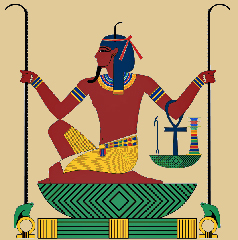
An primeval Egyptian god, one of the Ogdoad of Hermopolis. Together with his female pendant Hauhet he personifies infinite space. It is their task to wake the sun-god every morning. He appears as a frog or as a man with the head of a frog.
Huh was one of the oldest Egyptian gods in ancient Egyptian history, the deification of eternity in the Ogdoad. The name Huh also spelled as Heh, Hah, Hauh, Huah, or Hahuh, whose name means endlessness. He was the god of infinity and time, the god of long life and eternity. Huh has no gender, but has the aspect that can represent as male or female. Huh is the male aspect and Hauhet also known as Heh or Hehet is the female aspect.
Like the other concepts in the Ogdoad, Huh is also portrayed as a man with the head of frog or as a frog itself. Hauhet is portrayed as a woman with the head of snake or as a snake itself.
Sometimes, he also depicted as a crouching man holding a palm stem in each hand with shen ring at the base of each palm stem, the Egyptian sign of long life. The shen ring symbolized infinity. The image of Heh with his arms raised was the hieroglyph for the number one million, which was essentially considered equivalent to infinity in Egyptian mathematics. So, he was also given the title as “the god of millions of years”.
Hauhet
Hauhet is an Egyptian goddess and is represented as a frog. She was the goddess of immeasureable infinity. She is one of the Ogdoad. The Ogdoad are eight Egyptian dieties who were especially worshipped in Hermoplic in Upper Egypt. They formed the basis of the creation myths. The Ogdoad were made up of four goddesses and four gods. The goddesses were represented as either frogs or humans with frog heads. The gods were represented as either snakes or humans with snake heads.
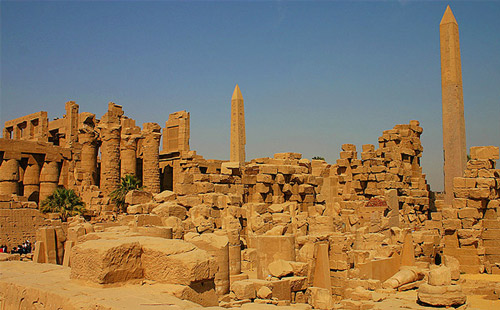
Mut
A primordial Egyptian goddess, patroness of the city of Thebes, where she was worshipped as a vulture. At Thebes she replaced Amaunet as the consort of Amun. With Amun and her adopted son, the moon-god Chons, she forms a powerful triad. They were worshipped in the large Amun temple in Luxor.
Mut, whose name means "mother", was also a sky goddess and 'mother of the mothers', from whom everything originates. In an annual marital ceremony, Amun came from his temple in Karnak to Luxor to visit her. She was portrayed as a vulture, or as a woman with the head of a vulture, dressed in a bright red or blue dress. At Thebes, Mut was syncretized with the goddess Sakhmet.
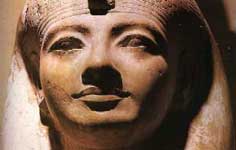 Mut was an ancient Egyptian Mother Goddess, the queen of all gods. The name Mut also spelled as Maut or Mout, whose name means “mother”. Mut was the great mother goddess of Egypt. She was referred as the great “world mother” and mother of the pharaohs.
Mut was an ancient Egyptian Mother Goddess, the queen of all gods. The name Mut also spelled as Maut or Mout, whose name means “mother”. Mut was the great mother goddess of Egypt. She was referred as the great “world mother” and mother of the pharaohs.
The Egyptian often believed that Mut represents the grandmother figure and Isis represents the mother figure. Mut is portrayed as a woman with the wings of a white vulture wearing a double crown that symbolized Upper Egypt and Lower Egypt, holding the scepter and the ankh on her hand with the feather of the goddess Ma’at at her feet. She also sometimes, is depicted as a white vulture, cobra, cat, cow, or as a lioness.
According to myth, Mut was one of the few goddesses who were self created. She was given a title and called as, “She Who Gives Birth, But Was Herself Not Born of Any”. She was also given other titles, such as “World Mother”, “Eye of Ra”, “Queen of the Goddesses”, “Lady of Heaven” and “Mother of the Gods”. Originally, she was the female counterpart of Nun and she adopted Montu, god of war as a son.
However, during the Middle Kingdom in Thebes, Amaunet was replaced by Mut to become the wife of the great god Amun. Monthu also replaced by the god of the moon, Khonsu. The rulers of Egypt each supported her worship in their own way to emphasize their own authority and right to rule through an association with Mut.
In Egypt, the marriage of Mut and Amun was one of the great festivals celebrated each year by the Egyptians. Mut, Amun and Khonsu were worshipped as a trinity at her temple Luxor.
Khonsu (Chons)
The Egyptian god of the moon, son of Amun and Mut with whom he forms a triad at Thebes. As the 'master of time' he is sometimes identified with the god Thoth. In human form he is depicted a young man in the posture of a mummy with the child's side lock and the curved beard worn by the gods, but also with a full moon and a crescent on his headdress.
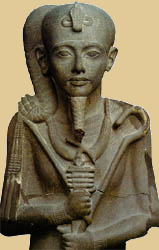 Khonsu was an ancient Egyptian God of the Moon since the earliest times in Egyptian Mythology. His name Khonsu also spelled as Chonsu, Khensu, Khons, Chons or Khonshu which means “The Traveller” or “The Wanderer”, reflects to the moon wandering across the night sky. He is also revered as the god of time.
Khonsu was an ancient Egyptian God of the Moon since the earliest times in Egyptian Mythology. His name Khonsu also spelled as Chonsu, Khensu, Khons, Chons or Khonshu which means “The Traveller” or “The Wanderer”, reflects to the moon wandering across the night sky. He is also revered as the god of time.
Khonsu also had given titles such as Embracer, Pathfinder, and Defender as he was thought to watch over night travelers. Khonsu was invoked to protect against wild animals, increase male virility, and to aid with healing. It was believed that Khonsu caused the crescent moon to shine, cattle to become fertile, women to conceive and every throat of the people were filled with fresh air.
His appearance portrayed as a young man wrapped in white mummy wrapping with the royal sidelock and punt beard hair (worn by Egyptian children), wearing lunar headdress that shows the disk of a full moon cradled in a crescent new moon. He holds the crook and flail with only his hands that free from the mummy wrapping. Occasionally, Khonsu also depicted as a falcon headed man wearing wearing the crescent of the new moon subtending the disc of the full moon on his head.
In early times, in “Cannibal Hymn” (part of the Pyramid Texts) Khonsu is a bloodthirsty deity, who helps the deceased king to slay deity enemies in the Underworld which describe him as “Khonsu who lives on hearts”. He appears to be a violent and dangerous god but he went through a complete transformation of character during time.
Khonsu was associated with a number of other gods such as Thoth, Ra, Shu, Min, Horus and Osiris. He also appears in several different aspects as Khonsu the Child (Khonsu pa-khered) or Khonsu the Provider (Khonsu pa-ir-sekher) or Khonsu, decider of the life span (Khonsu heseb-ahau).
According to the myth, Khonsu is the son of Amun and Mut, together constituting the Theban Triad. Nevertheless, he is also considered to be the son of Sobek and Hathor (associate him to Horus) and son of Osiris in Edfu.
Khonsu was worshipped throughout Egypt and many temples were built to honour him including temples at Memphis, Edfu and Hibis, but his main cult center was located at Thebes.
by Micha F. Lindemans
"Ogdoad." Encyclopedia Mythica from Encyclopedia Mythica Online.
[Accessed December 07, 2010].
Source Here
Liked this article? Dive deeper into personal growth and wellness! Check out CrystalWind.ca for spiritual wisdom or explore AromaWorx.ca for natural well-being tips. Spread the positivity—share this with friends on their happiness journey!
Let’s Chat! Drop Your Thoughts Below! ![]()
Latest Articles
Dive into the Mystical World of the Crystal Wind Oracle Deck!
Get All the Enchanting Details Now!
NEW Expanded Boxed Edition!
Now with 58 Cards for Richer Wisdom!

Imagine a world of inspiration and healing, free for all—made possible by YOU!
Donate Now—Ignite the Magic at CrystalWind.ca!

Epilepsy - Finding A Cure
Your donation can make a difference!
Help us find a cure – donate now!
Unlock Your Light: Join Lightworkers Worldwide on CrystalWind.ca!
Articles: Hindu Mythology
Articles: Egyptian Mythology
Articles: Compendium
Follow Us!
Featured This Month
Cancer Mythology
The Mythology of Cancer: A Celestial Tale of Loyalty and Sacrifice Among th... Read more
Sun in Cancer
Cancer Sun Sign Characteristics Overview The name "Cancer" comes from Latin, ... Read more
Egyptian Zodiac/Astrology
Egyptian astrology was one of the earliest forms of astrology. The Egyptians w... Read more
Abalone Shell
Echos Of The Ancestors Abalone strengthens the structure of the body and th... Read more
Lammas by The Hedgewitch
Although in the heat of a Mid-western summer it might be difficult to discer... Read more
Lugh - Celtic God Of The Sun
The god Lugh was worshiped in Ireland as a deity of the sun. This connection... Read more
Chalcedony
The Stone Of Orators Chalcedony was very popular as a decorative stone in ant... Read more













































